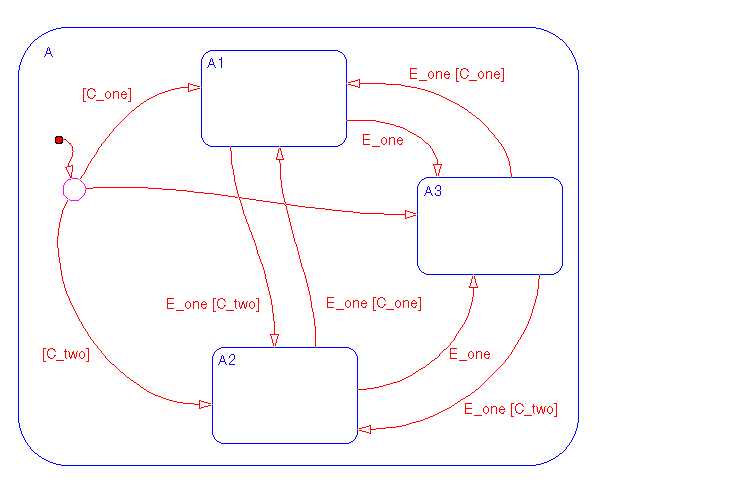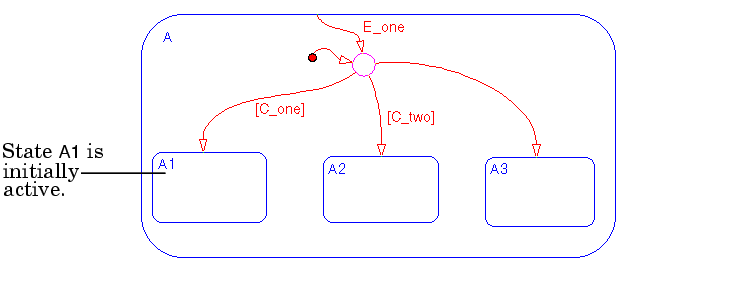

| Stateflow |   |
What Is an Inner Transition?
An inner transition is a transition that does not exit the source state. Inner transitions are most powerful when defined for superstates with exclusive (OR) decomposition. Use of inner transitions can greatly simplify a Stateflow diagram.
Example One: Before Using an Inner Transition
This is an example of a Stateflow diagram that could be simplified by using an inner transition.

Any event occurs and awakens the Stateflow diagram. The default transition to the connective junction is valid. The destination of the transition is determined by [C_one] and [C_two]. If [C_one] is true, the transition to A1 is true. If [C_two] is true, the transition to A2 is valid. If neither [C_one] nor [C_two] is true, the transition to A3 is valid. The transitions among A1, A2, and A3 are determined by E_one, [C_one], and [C_two].
Example One: Inner Transition to a Connective Junction
This example shows a solution to the same problem (Example One) using an inner transition to a connective junction.

Any event occurs and awakens the Stateflow diagram. The default transition to the connective junction is valid. The destination of the transitions is determined by [C_one] and [C_two].
The Stateflow diagram is simplified by using an inner transition in place of the many transitions amongst all the states in the original example. If state A is already active, the inner transition is used to re-evaluate which of the substates of state A is to be active. When event E_one occurs, the inner transition is potentially valid. If [C_one] is true, the transition to A1 is valid. If [C_two] is true, the transition to A2 is valid. If neither [C_one] nor [C_two] is true, the transition to A3 is valid. This solution is much simpler than the previous one.
See Example: Processing One Event with an Inner Transition to a Connective Junction for more information on the semantics of this notation.
Example: Inner Transition to a History Junction
This example shows an inner transition to a history junction.

State Power_on.High is initially active. When event Reset occurs, the inner transition to the history junction is valid. Because the inner transition is valid, the currently active state, Power_on.High, will be exited. When the inner transition to the history junction is processed, the last active state, Power_on.High, becomes active (is re-entered). If Power_on.Low was active under the same circumstances, Power_on.Low would be exited and re-entered as a result. The inner transition in this example is equivalent to drawing an outer self-loop transition on both Power_on.Low and Power_on.High.
See Example: Use of History Junctions for another example using a history junction.
See Example: Inner Transition to a History Junction for more information on the semantics of this notation.
 | Labeling Default Transitions | What Is a Self Loop Transition? |  |